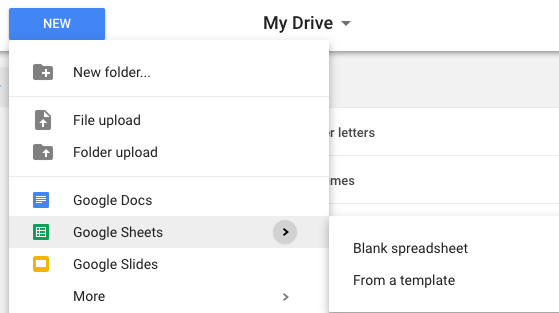It’s for your own sanity.
Before we dive into the why and how of tracking your submissions to literary magazines and agents, it’s worth it to first revisit whether your work is ready to be submitted at all. Of course you feel it is — you reached The End! you created an arc! you did it! — yet your plot’s conclusion does not mean the piece is complete.
Take a quick gander at that post I’ve linked to above, then let’s continue on with the unsexy task of CREATING A SPREADSHEET.
Ooh la la. Slow down, Katie. First, the why.
Why should I keep track of my submissions?
You only get one chance to make a first impression. (A writer who speaks in clichés; how novel!) Editors and agents will remember if you’ve submitted a piece to them multiple times. They don’t care that you’re resubmitting after a big revision. “Why wasn’t it thoroughly edited before she first shared it?” they’ll wonder. Knowing who read your work and when means you won’t hit up an editor more than once to pitch your same story.
Learn the pace at which you’re submitting to understand your confidence level. If you realize you’ve only submitted your short story to two magazines this month, maybe you’re feeling that the piece isn’t all that polished after all. Take a break from pitching it to revise, revise, revise, and maybe seek out a professional editor for guidance.
Be aware of the financial investment. Most writing contests cost $15-$25 to submit to. This submission fee is typically for altruistic reasons, like paying their judges or covering printing costs. It also helps weed out the less-serious writers who are pitching less-polished stories. Since we know you’re only going to submit work that’s 100% all-the-way no-doubt dunzo, it really is worth it to pay for contest submissions. Yet you want to know how much money is going out the door.
Manage expectations. Every literary magazine or agent has guidelines about simultaneous submissions and turnaround times. Keep all these notes in one place instead of Googling each magazine or agent for their rules when you haven’t heard from them for three months.
How should I keep track of my submissions?
Since there’s a lot of info you need in one place, it’s easiest to create a spreadsheet. If, like me, you occasionally have flashbacks to Computer Lab class — where you powered through Oregon Trail the week you were meant to learn about Excel — never fear; Google’s here.
You don’t have to have a Gmail account to use Google Drive, which is Google’s file cloud storage service. Google can direct you on how to get started, if you haven’t before used Drive, so I’m going to jump ahead to once you’ve selected to create a new spreadsheet.
The information you and I are interested in keeping track of with our submissions may differ. For my own spreadsheet, I have all literary magazine, literary agent and freelance story pitches in the same document. I could pull out story pitches for their own spreadsheet, but I think of this file as my one-stop management for all writing-related endeavors.
Here are the categories I’m interested in:
In case that’s tough to read, they are:
Status: I use ACCEPTED (in all-caps, because it’s still super exciting), Complete (meaning the outlet has passed on me), In Process (while I’m waiting to hear back) and Passed (for when I’ve opted to pass on their offer).
Publication: This is where I note the magazine’s name or literary agency. The latter is important because some agencies say that a no from one agent is a no from the agency itself. Whenever you prepare a query letter for a new agent, search your spreadsheet to see if you’ve submitted to someone at that agency in the past, and familiarize yourself with their guidelines.
Title: The name of the short story, collection, book, or writing pitch you’re sending their way
Competition: Is this a general story pitch? Query for a literary agent? Writing residency? Fall short story contest?
Date submitted: I find this column gives me a fascinating glimpse into my own creative psyche. I went from Feb. 23, 2016, to March 1, 2017, without pitching any stories or querying agents. A big chunk of that time was editing my short story collection before sending it off to my editor, but I also worked on new stories in the meantime. This reminded me that there’s still work being done — the important, creative work — that may not always feel like progress because query letters aren’t headed out the door. It’s quality, not quantity.
Other notes: This is where I drop in contest deadlines, turnaround times, feedback agents sent back, and submission rules, like for a magazine that only allows one submission per writer per calendar year (it happens!).
$: Most magazines allow free general submissions, so this column is mostly to manage your spending on writing contests. As I’ve mentioned, they’re typically $15-$25, and depending on how often you submit, it adds up. Determine what you want your monthly or annual budget to be for these opportunities, and keep an eye on this column.
Simultaneous?: There are still some magazines and agents who don’t allow simultaneous submissions, meaning sending your story or book query to other magazines/agents before they’ve had a first go at it. If they don't allow it, the submission guidelines on their website will be clear about it.
While you’re puttering around with the category row, select to freeze it so it’ll follow your scrolling:
I’ve pulled out some examples to show how this looks in practice:
You’ll notice I highlight acceptances in green because IT’S SO DAMN FUN to celebrate our wins. I hope you take the time to do so. Also, keep the faith: I have so many more rows with a status of Complete than ACCEPTED. We’re each trying our best. Don’t stop writing just because your work wasn’t the right fit for one person.
How are you keeping track of your writing submissions? Any advice for me in my spreadsheet, too?
You might also be interested in:
Want to get your hands on the studies and research I create for writers and creatives like you?
Click here!





